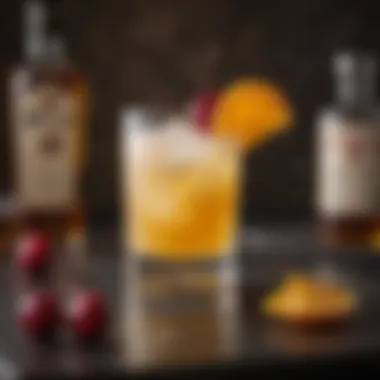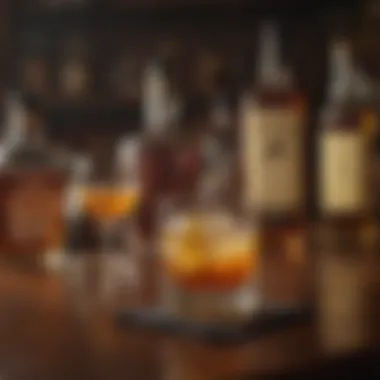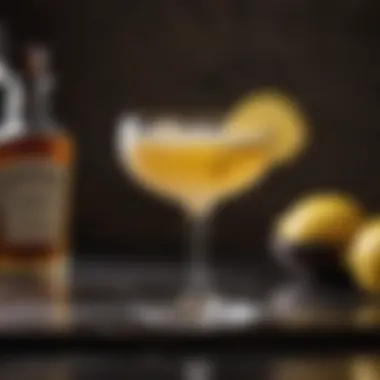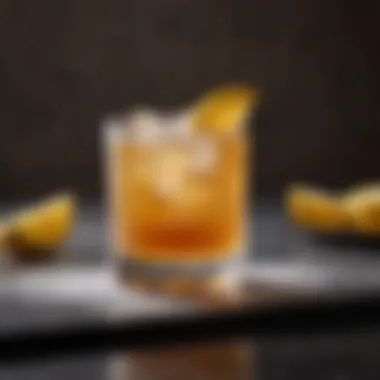The Whiskey Sour: Explore Its Original Recipe


Intro
The Whiskey Sour stands as a stalwart in the realm of cocktails. Its rich history and precise flavors reflect a time when cocktails were crafted with care and intention. This drink is a compelling fusion of whiskey, citrus, and sweet elements, making it both refreshing and complex. Understanding its original recipe provides insight into the cocktail's evolution, appealing to those interested in culinary history as well as flavor balance.
Recipe Overview
Recipe Name
Whiskey Sour
Description of the Dish
The Whiskey Sour is a classic cocktail that blends the bold character of whiskey with the tangy brightness of citrus juice, typically lemon. The addition of a sweetening agent, often simple syrup or sugar, enhances the drink's complexity. This trio of flavors creates a harmonious balance, often served either shaken with ice or blended until frothy. This drink's versatility allows it to be adapted, yet the traditional version remains highly revered.
Ingredients
List of Ingredients with Measurements
- 2 ounces bourbon or rye whiskey
- 3/4 ounce fresh lemon juice
- 1/2 ounce simple syrup
Special Notes on Ingredients
- For a sweeter profile, consider using a richer syrup or adding muddled fruit such as cherries.
- Substitutes for fresh lemon juice can include bottled lemon juice, though fresh is preferred for flavor.
- Some variations use egg white, which adds a silky texture and frothiness to the drink.
The Whiskey Sour's composition is a testament to cocktail craftsmanship. Each ingredient plays a crucial role in achieving the desired flavor, showcasing the importance of quality and freshness in preparation.
Intro to the Whiskey Sour
The Whiskey Sour stands as a classic example of cocktail craftsmanship, embodying the ideal balance of flavors. This drink has a rich history and distinct preparation method that makes it a staple among cocktail enthusiasts and casual drinkers alike. The importance of understanding the Whiskey Sour lies not just in its flavor profile but also in its cultural significance and enduring popularity.
At its core, the Whiskey Sour comprises a few fundamental ingredients: whiskey, citrus juice, and a sweetening agent. This combination creates a harmonious blend that appeals to a wide range of palates. Learning about the Whiskey Sour can enhance one’s appreciation for cocktails and offer insight into the delicate interplay of sweet and sour flavors.
Exploring the origins of the Whiskey Sour, as well as the evolution of its recipe, reveals much about cocktail culture and the artistry of mixology. The drink's simplicity is deceptive; while it may seem like a straightforward concoction, mastering the Whiskey Sour requires a nuanced understanding of each ingredient and how they interact.
Moreover, the historical context surrounding the Whiskey Sour adds depth to the experience. From its beginnings in the early 19th century to its rebirth during the Prohibition era, the cocktail’s journey provides valuable lessons about resilience and creativity in the face of challenges.
Ultimately, this overview seeks to provide readers with a comprehensive guide that encapsulates the essence of the Whiskey Sour. By delving into its historical context and ingredient composition, one can truly appreciate the drink’s place in both culinary and cultural landscapes. An understanding of the Whiskey Sour has the potential to enrich personal cocktail experiences and foster a deeper connection to the art of bartending.
Historical Context
Understanding the historical context of the Whiskey Sour provides essential insight into its significance as a cocktail. The evolution of this drink mirrors broader trends in society, culture, and the art of cocktail-making. By exploring its origins and the impact of the Prohibition era, one gains a deeper appreciation for its place in the cocktail canon. The Whiskey Sour is not merely a drink; it is a cultural artifact that tells a story of change, innovation, and resilience in the face of adversity.
Origin of the Cocktail
The origins of the Whiskey Sour can be traced back to the 19th century. This period marked the contemporary crystallization of many classic cocktails, including the Whiskey Sour. The first known written recipe appeared in "The Bartender's Guide" by Jerry Thomas in 1862, a landmark text in the history of mixology. The recipe featured whiskey, lemon juice, and sugar, showcasing the essential elements that define this cocktail today.
Whiskey itself has a rich history, particularly in the United States where it became a favored spirit among many. The style of the Whiskey Sour represents not just an individual drink but also a lifestyle. For many, enjoying a Whiskey Sour signifies a refined taste for quality spirits and elegance in social situations. This cocktail has remained popular due to its distinct yet harmonious flavors, making it accessible and appealing to a wide audience.


Prohibition Era Influence
The Prohibition era from 1920 to 1933 played a pivotal role in shaping cocktails, including the Whiskey Sour. During this time, the production and sale of alcoholic beverages were banned in the United States. This led to innovative adaptations in cocktail recipes, as bartenders sought to mask the inferior quality of illegal spirits.
The Whiskey Sour was no exception. Many individuals began experimenting with different types of whiskey and varying proportions of the sour and sweet components in an attempt to enhance the flavor profile. This adaptive spirit preserved the cocktail's popularity despite the restrictive environment.
Prohibition also facilitated the emergence of speakeasies, secret bars where the illicit sale of alcohol occurred. These hidden establishments became hotspots for cocktail culture, and the Whiskey Sour found new life within their dimly lit confines. The cocktail regained its status as a classic drink with a storied past, appreciated both for its flavor and its historical significance.
The influence of this era endures today, as it laid the groundwork for the revival of classic cocktails in the late 20th century. Furthermore, the Whiskey Sour is often featured in cocktail menus as a nod to its resilience, reminding drinkers of its journey through challenging times. The ongoing fascination with this cocktail speaks to its adaptability and the creativity of those who crafted and enjoyed it.
Ingredients of the Original Recipe
The importance of the ingredients in the Whiskey Sour cannot be overstated. Each component plays a crucial role in achieving the harmonious balance of flavors. The base spirit, the sour component, and sweetening agents come together to create the distinctive taste of the cocktail. Choosing quality ingredients is essential. The overall experience of the drink can be significantly influenced by the selection of whiskey, the type of citrus used, and the choice of sweeteners.
Base Spirit: Whiskey
Types of Whiskey
Whiskey is the cornerstone of the Whiskey Sour. The type of whiskey used can alter the drink’s flavor profile. Bourbon, rye, and blended whiskey are common choices. Bourbon tends to offer a sweeter profile with notes of vanilla and caramel. This makes it a popular choice among many cocktail drinkers.
Rye whiskey, on the other hand, provides a spicier and more robust flavor. This can enhance the overall complexity of the drink. Each type brings its unique characteristics, making it important to select the right whiskey based on personal taste preferences.
Choosing Quality Whiskey
The quality of whiskey used also matters significantly. Opting for a higher-quality whiskey can elevate the cocktail. A well-crafted whiskey offers smoothness and richness, which is essential for a balanced drink. The unique characteristics of the chosen whiskey can complement the sour and sweet elements effectively. However, price and accessibility can be considerations. Finding a whiskey that fits one's budget without sacrificing quality is advisable.
Sour Component
Use of Fresh Citrus
Fresh citrus is a vital ingredient in the Whiskey Sour. The acidity from fresh citrus helps to cut through the sweetness of the whiskey and sugar. It brings brightness and freshness to the drink. Using fresh juices instead of bottled alternatives is highly recommended, as they provide a vibrant flavor and aroma that enhances the overall drinking experience. Often, the freshness of the juice can make a noticeable difference in the cocktail’s quality.
Preferred Citrus Types
Common choices for sour components are lemon and lime. Lemon juice is traditionally used, lending a strong tartness that contrasts beautifully with the sweetness of the other ingredients. However, lime can also be preferred for those seeking a different type of tang. A careful selection between lemon and lime can affect the drink’s taste. Depending on the desired profile, each citrus type offers distinctive benefits and characteristics.
Sweetening Agents
Sugar Syrup Options
Sugar syrup is the traditional sweetener used in a Whiskey Sour. It ensures that the sweetness is perfectly balanced with the sourness. Using simple syrup allows for smooth integration into the cocktail, which is essential for achieving a cohesive flavor. It is advisable to make your own simple syrup, using equal parts of sugar and water heated until dissolved. This way, the sweetness can be adjusted to individual taste, enhancing the experience.
Alternative Sweeteners
An increasing number of mixologists are exploring alternative sweeteners. Options like honey syrup or agave nectar can impart different flavors and complement the whiskey's characteristics. These alternatives can offer unique profiles and reduce reliance on sugar. However, when using these substitutes, it is important to test the balance of flavors. The key is to maintain a harmonious relationship among the elements in the cocktail.
The Classic Recipe
The classic recipe for the Whiskey Sour is fundamental to understanding the essence of this cocktail. This section elaborates on the significance of precise ratios, ingredients, and preparation methods that create the balance of flavors essential to the drink's identity. The Whiskey Sour combines the robust character of whiskey with the crispness of citrus. It demonstrates the harmony that can be achieved through simple components, a principle that resonatesthroughout cocktail culture.


Proportions and Measurements
The proportions in the original Whiskey Sour recipe are crucial for achieving the right taste. A typical ratio is 2 parts whiskey, 3/4 part fresh lemon juice, and 1/2 part simple syrup. This specific measurement facilitates a delicate equilibrium between sweetness and acidity.
When selecting whiskey, the choice between bourbon or rye can influence the flavor profile. Bourbon offers a sweeter, fuller body, while rye presents a spicier character. Understanding these differences helps in making an informed choice based on personal preference.
It's essential to note that adjustments can be made based on individual taste. Some might prefer a slightly sweeter or more tangy drink. As a guideline, if the drink feels too sweet, reducing the syrup may benefit the overall balance. The same goes for lemon juice – a more tart flavor can enhance the freshness, as long as one is careful not to overpower the whiskey itself.
Step-by-Step Preparation
Preparation of the Whiskey Sour is straightforward but requires attention to detail. Here is the step-by-step guide to making this classic cocktail:
- Gather Ingredients: You will need whiskey, fresh lemon juice, and simple syrup. Don't forget ice and a shaker.
- Measure Components: Using a jigger, pour 2 ounces of whiskey into the shaker, followed by 3/4 ounce of fresh lemon juice, and 1/2 ounce of simple syrup. Accurate measuring is critical for the best flavor.
- Add Ice: Fill the shaker with ice cubes up to two-thirds full. This ensures proper chilling and dilution during mixing.
- Shake Well: Secure the shaker lid and shake vigorously for about 15 seconds. A good shake not only mixes the ingredients but also chills the drink.
- Strain and Serve: Using a fine mesh strainer, pour the mixture into an ice-filled glass. This step filters out any pulp or ice shards, ensuring a smooth drink.
- Garnish: Traditionally, a cocktail cherry or a lemon slice is added as a garnish. This simple addition enhances presentation and adds a hint of aroma.
The simplicity of the Whiskey Sour makes it accessible while also showcasing the care necessary to achieve flavor balance. The cocktail contains three main ingredients, making it a great starting point for novice bartenders.
Serving Guidelines
The serving guidelines of the Whiskey Sour are integral to its presentation and enjoyment. Creating the perfect setting for this classic cocktail enhances the drinking experience significantly. Proper serving not only showcases the visual aesthetics but also permits the flavors to shine through. When considering how to serve the Whiskey Sour, one must account for aspects such as glassware selection and garnishing techniques. These details contribute greatly to the perception of the drink, influencing both taste and presentation.
Glassware Selection
Choosing the right glassware is essential for the Whiskey Sour. Traditionally, the drink is served in an Old Fashioned glass or a coupe. The Old Fashioned glass, with its sturdy base, allows for easy sipping and stability. It provides a sense of nostalgia that aligns with the drink's long history.
On the other hand, the coupe glass offers a more elegant appearance. Its curved shape presents the drink beautifully, enhancing any garnishes used. The choice between these two may depend on the occasion. For casual gatherings, an Old Fashioned glass is ideal. For more formal settings, the coupe might be preferred. The glassware used influences both the aesthetic and the social experience of cocktail consumption.
Garnishing Tips
Cocktail Cherries
Cocktail cherries are a popular choice when garnishing a Whiskey Sour. Their rich, sweet flavor complements the sour notes of the cocktail. Typically, the use of quality maraschino cherries adds a touch of sophistication. These cherries often come in syrup which can mix well with the drink, enhancing its sweetness without overpowering the balance of flavors. However, one must be cautious; overly sweet cherries can alter the intended taste of the cocktail.
It is worth noting that some prefer to use Luxardo cherries, a gourmet option known for their deep flavor and dark color. Luxardo cherries not only offer an indulgent element but also visually contrast with the bright hues of the cocktail, enhancing its presentation.
Citrus Peels
Citrus peels serve as another significant garnish for the Whiskey Sour. Typically, lemon or orange peels are used. Their bright colors add vibrancy, while the essential oils provide an aromatic experience. When adding citrus peels, a twist or a spiral can elevate the look of the drink considerably. The oils released from the peel provide a refreshing scent that complements the drink's flavors, creating a more rounded experience.
The unique feature of citrus peels is their ability to enhance aroma without adding excess moisture or sweetness. This distinction makes them a favorable garnish option. However, care should be taken to avoid using white pith, as it can introduce a bitter note, detracting from the overall smoothness of the Whiskey Sour.
Properly chosen garnishes not only beautify the cocktail but also enhance the flavors, making the experience richer and more enjoyable.
Variations of the Whiskey Sour
The variations of the Whiskey Sour showcase the cocktail's versatility. By altering or adding elements, bartenders can create experiences that cater to individual palates. This section uncovers notable iterations of this classic drink, revealing how they contribute to the cocktail culture. Understanding these variations enriches one’s appreciation for the original recipe and encourages experimentation with flavor profiles.
The New York Sour


The New York Sour is a charming twist on the classic. It retains the fundamental components of whiskey, lemon juice, and simple syrup. However, what sets it apart is the addition of a red wine float on top. This technique creates a visually appealing gradient and enhances the drink's complexity. The choice of wine is essential; a fruity, young red, like a Shiraz or Cabernet Sauvignon, works well.
This variation enriches the flavor, smoothing the acidity of the lemon juice while adding a hint of tannin from the wine. To prepare, first combine the whiskey, lemon juice, and syrup in a shaker with ice. Shake well and strain into a glass with fresh ice. Finally, carefully pour the red wine over the back of a spoon, allowing it to float on top. This drink not only provides a unique taste but also presents beautifully, making it perfect for gatherings.
The Boston Sour
The Boston Sour expands on the classic by incorporating egg white into the mix. The egg white adds a rich, velvety texture that transforms the cocktail. The process involves shaking all ingredients without ice first, known as a dry shake, to emulsify the egg white. Then, perform a second shake with ice to chill and dilute the drink.
This method results in a frothy top layer and balances the whiskey's boldness with the tartness of lemon. As a result, the Boston Sour boasts a satisfying mouthfeel, which enhances the overall sipping experience. For those cautious about using raw eggs, pasteurized egg whites are a safe alternative.
Other Contemporary Twists
Many bartenders innovate beyond the traditional variations. Ingredients can be swapped out or added based on seasonal availability or personal preference. Farms and local markets provide fresh fruit options, which can be muddled or substituted for standard lemon juice.
For example:
- Ginger Whiskey Sour: Incorporates fresh ginger or ginger syrup for a spicy twist.
- Herbal Whiskey Sour: Adds fresh herbs like basil or mint, introducing aromatic complexity.
- Spicy Whiskey Sour: Infuses chili or jalapeño for those who seek a kick.
Another recent trend involves utilizing flavored whiskeys, such as honey or apple varieties, enhancing the cocktail's sweetness and depth. These variations allow consumers to explore new dimensions of flavor while maintaining the essence of the Whiskey Sour.
"The beauty of the Whiskey Sour lies in its adaptability, making it a canvas for creativity in cocktail crafting."
In summary, the variations of the Whiskey Sour demonstrate how creative interpretations breathe fresh life into classic cocktails. Each new form offers something different while preserving the heart of the original recipe.
Cultural Significance
The Whiskey Sour holds a notable place in cocktail culture and society. Its origins date back to a time when the combination of simple ingredients captured the essence of enjoyable drinking. This drink represents more than a mere mix of whiskey, sugar, and sour; it embodies a historical narrative that links generations of drinkers.
The Whiskey Sour in Popular Media
Throughout history, the Whiskey Sour has made appearances in various media, illustrating its enduring appeal. Films, television shows, and literature often reference the cocktail, showcasing it in scenes that evoke camaraderie, sophistication, or nostalgia. For example, characters in shows such as Mad Men may be found enjoying a Whiskey Sour, symbolizing a certain lifestyle and era. These portrayals help cement the drink's place in popular culture. The mention of its name alone can stir memories of social gatherings and shared experiences, making it significant beyond just taste.
Moreover, the cocktail has been featured in numerous books dedicated to bartending and mixology, highlighting its role as a classic choice for both beginners and experienced mixologists. This reinforces its status as a foundational drink in the cocktail lexicon.
Role in Cocktail Culture
In the broader context of cocktail culture, the Whiskey Sour is a vital part of the conversation. It embodies the balance and simplicity that many mixologists strive for. The drink serves as a benchmark for quality and technique, emphasizing the importance of using fresh ingredients and precise measurements. Just like the Old Fashioned and the Martini, the Whiskey Sour is often used as a teaching tool in bars and restaurants, where new bartenders learn about flavor balance and cocktail construction.
The Whiskey Sour's flexible nature allows for endless variations while maintaining the core principles of cocktail craft. This adaptability further underscores its cultural significance; it invites experimentation while respecting tradition. As trends in gastronomy shift and evolve, the Whiskey Sour remains a central figure, linking the past to the present with its rich flavor and history.
In summary, the cultural significance of the Whiskey Sour extends beyond its ingredients, touching on themes of community, nostalgia, and the art of cocktail making. It serves as a reminder of the social aspects of drinking, weaving its legacy into the fabric of cocktail history.
Closure
The Whiskey Sour stands as a significant cocktail steeped in history and craftsmanship. Its importance lies not only in its delightful balance of flavors but also in its ability to adapt through various cultural contexts. This article encapsulates the rich narrative surrounding the cocktail, tracing its roots and evolution while emphasizing the essential ingredients that create its signature taste.
The Enduring Appeal of the Whiskey Sour
The enduring appeal of the Whiskey Sour can be attributed to a combination of factors that resonate well with cocktail enthusiasts and casual drinkers alike. At the core, the harmony between the whiskey, sour elements, and sweeteners offers a profile that is both complex and approachable.
- Flavor Balance: The whiskey provides depth, the citrus adds brightness, and the sweetener rounds out the harsh edges. This equilibrium captivates the palate.
- Versatility: The Whiskey Sour can transition seamlessly from a refined sipping drink to a festive party offering. Seasonal adaptations, like using different citrus fruits, maintain its relevance.
- Cultural Significance: The cocktail’s presence in films, literature, and popular culture enhances its stature. References in media not only highlight its charm but elevate its perceived sophistication.
- Craftsmanship: For many, making a Whiskey Sour offers a canvas for creativity. Bartenders and home enthusiasts refine their techniques, pursuing the perfect concoction.
- Accessibility: With ingredients that are often readily available, the Whiskey Sour invites experimentation. Home bartenders feel empowered to explore variations and make the drink their own.
"The Whiskey Sour illustrates the art of balance in mixology, serving both as a foundation for beginners and a platform for advanced creativity in cocktails."
As this article demonstrates, the Whiskey Sour transcends merely being a cocktail; it embodies tradition, skill, and cultural exchange. Its steady relevance in the cocktail landscape reaffirms its status.







